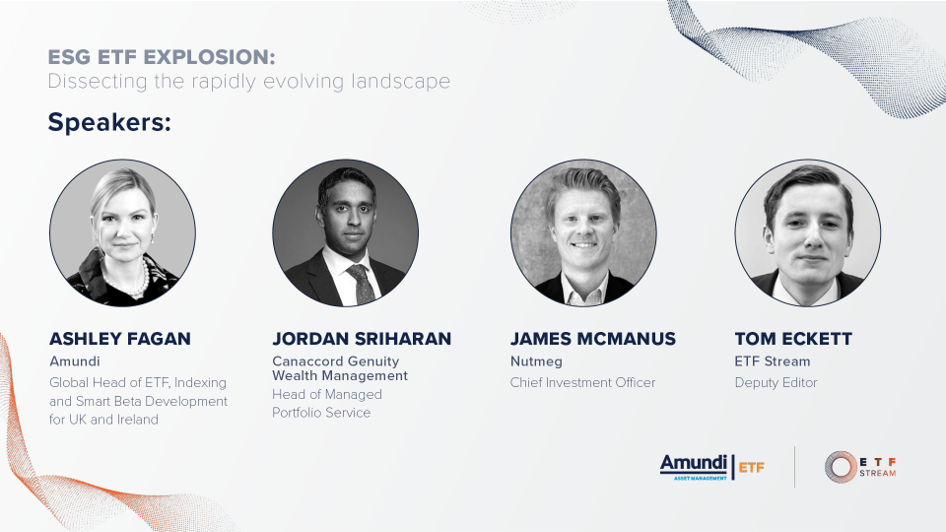ESG ETF selection, how to approach engagement and future product innovation were the key areas discussed during ETF Stream’s recent ESG ETF webinar in partnership with Amundi.
The webinar, entitled ESG ETF explosion: Dissecting the rapidly evolving landscape, started by analysing the drivers behind the record inflows into ESG ETFs in 2020.
According to data from Amundi, ESG ETFs flows accounted for over 50% of the total inflows into European-listed ETFs last year taking total assets under management (AUM) to €90.4bn.
Ashley Fagan, global head of ETF, indexing and smart beta strategic clients and UK and Ireland strategy development at Amundi, said this was being driven by increasing investor awareness about the climate crisis society faces along with increasing pressure from regulators and governments.
“The acceleration in flows has been driven by bottom-up and top-down factors,” Fagan continued. “This will develop this year as well with climate high on government agendas highlighted by the US re-joining the Paris agreement.”
ESG ETF selection is becoming a daunting task for investors following the flurry of launches last year. Some 130 ESG ETFs were launched in Europe alone in 2020, according to Amundi, which accounts for 41.1% of total launches this side of the pond.
Jordan Sriharan, head of MPS and passive at Canaccord Genuity Wealth Management, said it is crucial ESG ETFs are aligned with their own in-house philosophy.
CGWM largely invests in more niche areas of the ESG ETF landscape rather than the broad index-tracking strategies meaning the firm has to be very aware of fund size and underlying asset liquidity, he added.
“Our focus is on more targeted thematic ideas in ESG such as battery technology so understanding the underlying operation effects is even more important.”
For James McManus, CIO at Nutmeg, the key importance is running a portfolio that is consistent from an ESG perspective.
This is why, he said, the firm tends to invest in approaches that have consistent outcomes and therefore leans to more “full fat” indices that have a real-world impact.
“Our clients are not interested in being ESG light,” he continued. “They want a true socially responsible investment (SRI) portfolio that delivers a different outcome in terms of ESG so factors such as tracking error [to the parent index] are less important.”
An area that is potentially being overlooked by investors is around the engagement policies of ETF issuers. According to a survey conducted by Amundi and ETF Stream, index and product were more important factors when undertaking ESG ETF due diligence versus the ETF issuer.
Fagan said that although engagement is an “underappreciated area” when it comes to ESG and selecting the right ETF issuer, it is important for investors to look at an ETF issuer’s ESG credentials in terms of voting and engagement.
According to a recent ShareAction report, European ETF issuers continued to engage more at shareholder resolutions on climate change and social issues than their US counterparts.
“It is important to make sure ETF issuers are aligned with the ESG ETFs they offer,” she continued. “Investors do not want to buy a climate ETF with an issuer that is voting against climate resolutions, for example.”
One area that remains a challenge for the ETF industry, according to McManus, is around divestment. The index-tracking nature of ETFs means they are unable to divest from companies unless the index provider is lobbied to change its approach.
“The gap here is index providers are not asset owners and the asset owners have to follow the index so it is a question of bridging that gap,” he said. “Challenging index construction, having a higher tracking error or self-indexing are all areas that could be looked at.”
Fagan added: “While divestment is not always possible for index investors, we view this as a last resort, preferring to engage and influencing positive change. This is something we look at collectively across index and active strategies.”
ESG ETF innovation
In terms of future ESG innovation, Sriharan said much work needed to be done in the sovereign bond space.
When the firm came to look at potentially incorporating sovereign bonds ESG ETFs in its portfolios, he said they had very similar exposures to the parent indices.
“We already own gilts and US Treasuries in our portfolios so why would we want an ESG ETF just because it is badged that way,” he stressed.
Meanwhile, McManus said the next stage of evolution would be ETF issuers looking to leverage their own ESG IP on strategies.
“What I would like to see is ETF issuers operating a semi-active approach which is the index plus the issuer’s view,” he explained. “As a fund buyer, it is very difficult when there are multiple versions of the same index.”
For Amundi, one key area of focus has been climate change ETFs. Last July, the firm launched three climate equity ETFs that track the EU Paris-aligned Benchmark (PAB).
They are:
Amundi Euro iSTOXX Climate Paris Aligned PAB UCITS ETF (PABZ)
Amundi MSCI Europe Climate Paris Aligned PAB UCITS ETF (PABE)
Amundi MSCI World Climate Paris Aligned PAB UCITS ETF (PABW)
“Climate change ETFs are a big focus for us,” Fagan added. “The launches give investors more clarity in terms of aligning with the Paris agreement.”





